This detailed project report aims to provide an overview of the production costs and profit analysis for cultivating watermelons on a one-acre farm. By examining various aspects such as initial investment, operational expenses, market trends, and potential earnings, this report will assist entrepreneurs in making informed decisions for profitable watermelon cultivation.

1-Acre Watermelon Farming Cost and Profit
What is Watermelon Farming?
Watermelon cultivation is a rewarding venture with the potential for substantial profits. This guide provides essential information for beginners and experienced farmers, covering key aspects such as land preparation, seed selection, planting techniques, irrigation, pest management, and harvesting methods. By following this comprehensive guide, you’ll gain valuable insights to maximize yields and achieve success in watermelon farming.
Market and Demand for Watermelon
According to Transparency Market Research, Europe and North America are the primary markets for watermelon seeds, with Europe being the largest global producer. The global watermelon market crossed USD 507.7 million in 2018 and is expected to increase at a CAGR of 5.8% over the period.
The increasing prevalence of obesity and related health issues, such as coronary heart disease, due to unhealthy eating habits and sedentary lifestyles is driving the demand for watermelon seeds. Additionally, the global fresh fruits market was valued at USD 551.1 billion in 2021, and it is anticipated to grow at a CAGR of 3.6% from 2022 to 2028. The rising consumption of fresh fruits and juices fuels the market’s expansion.
The Best Watermelon Varieties for High Productivity in Cultivation/Farming
- The Classic picnic watermelon is a reliable choice with disease resistance and suitability for long growing seasons. Charleston Gray is an heirloom variety known for its large cylindrical fruits and sweet, crisp, fiber less red flesh.
- Crimson Sweet is an open-pollinated picnic-type heirloom variety with round fruits, while Georgia Rattlesnake offers large oblong fruits with bright pink, sweet flesh.
- Klondike Blue Ribbon Striped features oblong melons with thin but tough rinds and bright crimson, super sweet flesh.
- Lastly, Sweet Princess is a disease-resistant heirloom watermelon with oblong fruits, a marbled rind, and pink, crisp, and sweet flesh with small seeds.
Essential Packages and Best Practices for Watermelon Farming Excellence
Climate for Watermelon Cultivation: Watermelons thrive in warm climates with ample sunshine and dry weather. They can be grown year-round. However, they are sensitive to frost and require protection in areas with colder winters. Greenhouses can provide the necessary frost protection for watermelon cultivation.
Soil for Watermelon Farming: Watermelons prefer sandy loam soil that drains well. They can also grow in black soil and sandy soil. The soil should have good organic content and proper drainage to prevent waterlogging, which can lead to fungal infections in the vines.
PH for Watermelon Cultivation: The soil pH for farming should be between 6.0 and 7.5. Acidic soil can adversely affect seed germination and plant growth. While neutral pH is preferred, slightly alkaline soil can support watermelon cultivation.
Irrigation for Watermelon Growing: Watermelons are considered a dry-season crop and require irrigation throughout their growth cycle. Before sowing, the watermelon beds should be irrigated two days in advance, and another irrigation should be done five days after sowing. As the plants grow, weekly irrigation is recommended, ensuring that water stress is avoided to prevent fruit cracking.
Irrigation should be focused on the root zone, avoiding wetting of vines and vegetative parts during flowering and fruiting to prevent fungal diseases. Moisture should be maintained near the roots to promote the development of a taproot system. Irrigation frequency can be reduced as the fruits near maturity, and it should be completely stopped during harvesting to enhance flavor and sweetness.
Crop Rotation with Watermelon: Due to the risk of diseases, Watermelon should be grown on the same soil only after a gap of three years. Crop rotation with paddy or other vegetables like tomatoes and chilies is recommended to maintain soil health and prevent the buildup of pests and diseases.
Land Preparation and Planting Watermelon Seeds: Land preparation involves plowing the soil until it becomes a fine tilth. Watermelons can be seeded directly in the field or started in nurseries or greenhouses for protection against frost. Sowing time varies based on the region, with February to March for North India and November to January for West and North East India. Different sowing methods, such as pit, furrow, and hill, can be employed, each with specific spacing requirements.
Pollination in Watermelon Farming: Watermelon plants require pollination for fruit development. Both the flowers grow in the same plant but separately. Setting up artificial beehives in the watermelon field can help ensure pollination, with one hive per acre sufficient. Manual pollination can also be done by transferring pollen from the stamen of male flowers to the stigma of female flowers. Pinching out the tip of the branch after the fruit set can encourage the development of larger fruits.
Weed Control in Watermelon Farming: Weeding is necessary during the initial stages of watermelon growth. Care should be taken when using herbicides to avoid harming healthy plants. The first weeding is typically done around 25 days after sowing, followed by monthly weeding. Weeding becomes less necessary once the vines spread as they help suppress weed growth.
In case you missed it: 1-Acre Jackfruit Cultivation Cost and Profit Analysis: Project Report and Economics

Expenses of Cultivating Watermelon on 1-Acre Land: A Detailed Cost Report
Watermelon cultivation on a 1-acre land involves expenses for land preparation, high-quality seeds, fertilizers, irrigation, pesticides, labor, equipment, and miscellaneous costs. The total expenses average around $6,750. This comprehensive cost report offers valuable insights for farmers planning to engage in watermelon cultivation.
| Components | Cost (USD) |
| Land Rent/Ownership | $50 – $100 |
| Seeds | $30 – $50 |
| Fertilizers | $50 – $70 |
| Pesticides/Herbicides | $40 – $60 |
| Irrigation | $50 – $80 |
| Labor (including harvesting) | $120 – $150 |
| Machinery/Equipment Rental | $20 – $40 |
| Miscellaneous Expenses | $20 – $30 |
| Total Cost Range | $360 – $430 |
Total Returns and Net Profit1 Acre Watermelon Cultivation/Farming
- Total Yield: 22,000 kgs Price per kg: $0.7
- Total Revenue = Total Yield * Price per kg
- Total Revenue = 22,000 * $0.7
- Total Revenue = $15,400
Using the cost range provided earlier (total cost: $360 – $430), The Net returns for the watermelon cultivation on 1 acre
- Minimum Total Cost = $360 Maximum Total Cost = $430
- Net Returns = Total Revenue – Total Cost
- Minimum Net Returns = $15,400 – $430 = $14,970
- Maximum Net Returns = $15,400 – $360 = $15,040
Challenges and Risks in Watermelon Cultivation/Farming
Challenges and risks in watermelon cultivation include susceptibility to frost damage, fungal infections, and diseases like wilt and powdery mildew. Other challenges include water stress leading to fruit cracking, weed control, and the need for proper pollination. Market fluctuations and price volatility can also pose risks to profitability.
Key Points about Watermelon Cultivation/Farming
- Watermelon farming requires warm climates, 24-27°C temperatures, and well-draining sandy loam or black soil with pH 6.0-7.5.
- Regular irrigation is essential, while frost protection may be needed.
- In India, watermelons can be grown throughout the year in tropical regions or after frost in colder areas. Pollination can be managed through beehives or manual methods.
- Risks include weather fluctuations, diseases, and market price volatility.
- Proper disease management and market analysis are crucial for profitability.
In case you missed it: 1 Acre Guava Cultivation Cost and Profit Analysis: Production Economics and Project Report

Conclusion
Watermelon cultivation on a 1-acre farm can be profitable if managed properly. Despite facing weather conditions, diseases, and market fluctuations, the potential for high yields and favorable market prices can lead to significant profits. Careful planning, efficient management, and adherence to best practices can maximize profitability in watermelon farming.
- Ultimate Guide to Ossabaw Island Hog: Breeding, Raising, Diet, and Care
- Ultimate Guide to Juliana Pig: Raising Facts, Size, Diet, Care, and Lifespan
- Raising Lleyn Sheep: Disadvantages, Price, Uses, Characteristics, and Care
- Ultimate Guide to Meishan Pig: Breed Facts, Breeding, Raising, and Care
- Ultimate Guide to Teacup Pigs: Raising, Diet, Lifespan, Cost, and Care
- Guide to Raising Poll Dorset Sheep: Facts, Profile, Characteristics, Uses, and Care
- Ultimate Guide to Bighorn Sheep: Characteristics, Diet, Lifespan, Breeding, and Lifecycle
- Ultimate Guide to Raising Katahdin Sheep: Farming Facts, Breed Profile, Uses, and Care
- Ultimate Guide to Raising Oreo Cows: Belted Galloways Farming Facts, Profile, Uses, and Care